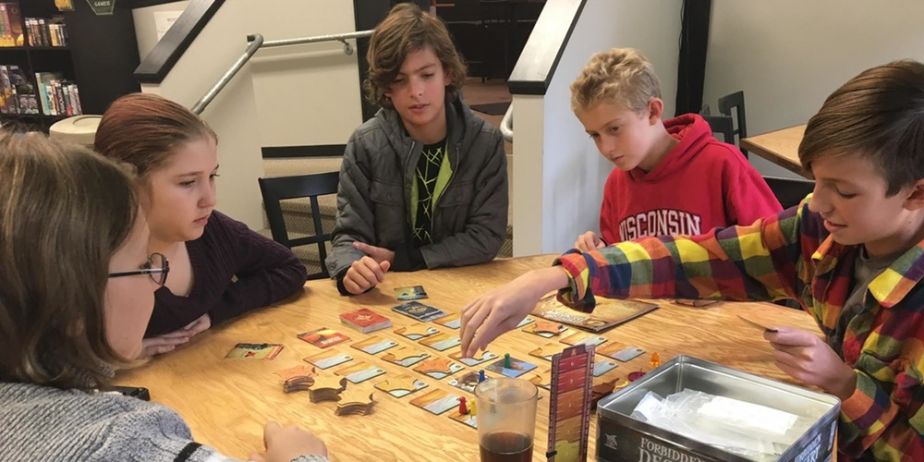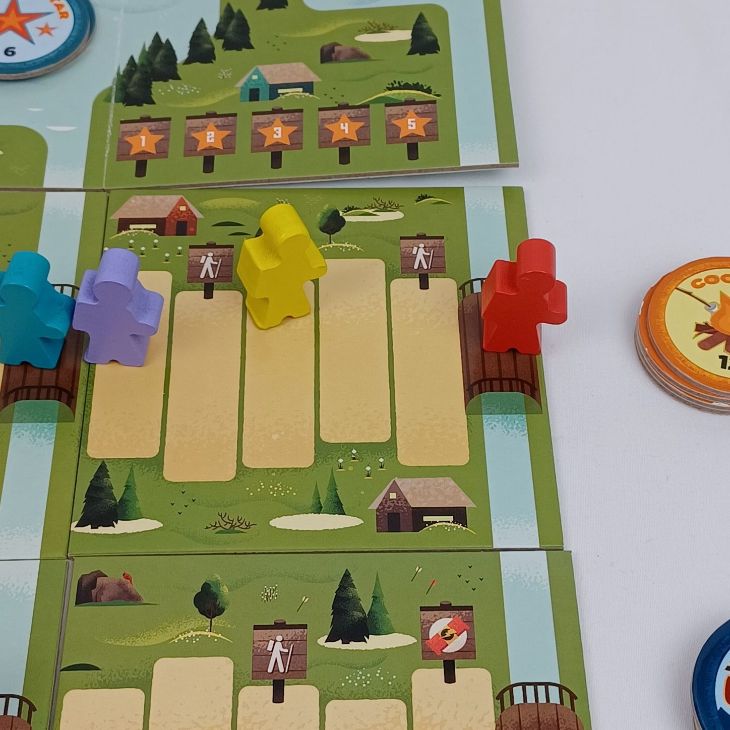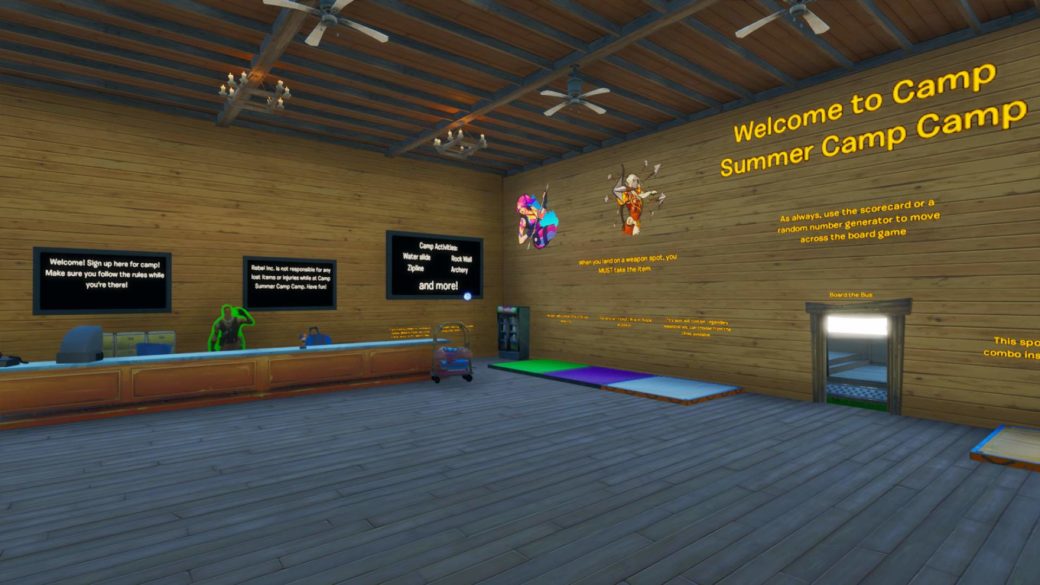Summer Camp was created by Phil Walker-Harding and released back in 2021. You can relive your camp memories in the game. In order to earn badges, you’ll compete with the other players in classic summer camp games. Making your own set of playing cards will assist you in the various activities. In Summer Camp, the main objective is to accumulate more points than the other players.
The player who accumulates the most camp experience points—points earned by obtaining merit badges, moving your pawns along the merit paths, and purchasing cards—wins. To learn more about the rules of the summer camp board game, please read this article.
The Basics
- For ages 10 and up
- For 2 to 4 players
- Approximately 45 minutes to complete
Geek Skills
- Counting & Math
- Logical & Critical Decision Making
- Reading
- Strategy & Tactics
- Hand/Resource Management
Learning Curve
- Child – Easy
- Adult- Easy
Setup For Summer Camp
Setting Up The Gameboard And Tokens
In the center of the table, set up the map board. Set the lake board on top. Following that, arrange the nine path boards in a 3×3 grid below the lake board. The order of the path boards is up to you. However, the paths ought to go from left to right.
ake the three participation and all-star merit badges from the box. Put them on the lake board in the appropriate locations. With the highest value at the top, arrange them in ascending order.
Depending on how many players are present, you should decide how many badges to display in the area. How many of each kind of badge you will use is indicated on the Lake Board. Due to the number of players, any badges that are not used are put back in the box.
Setting Up Activities
- Select three of the seven activities to use in the game. For your first game, the game suggests using cooking, outdoor activities, and water sports.
- For the activities, you selected to use, take the smaller boxes out of the main box.
- Take the corresponding merit badges from the box for each activity. No matter which of the three paths you choose for each activity, you will place these merit badges at its end. The number of badges you place will depend on the players. The badge with the highest number will be placed on top of the stack, followed by the badge with the next-highest number, and so forth. Any merit badges that are not used will be put back in the corresponding box.
- Four players: 12, 10, 8, and 6 badges
- Three players: 10, 8, and 6 badges
- Two players: 10 and 6 badges
- Take the cards out of the box for each activity you have selected. Each deck of cards will have four “move 1 space” cards. Put these cards to the side.
- The remainder of each activity deck’s cards is shuffled. Each deck will be set up on the left side of the pathway that the corresponding merit badges were next to. The top two cards from the deck should be turned over and put face up next to the draw pile.
- From the base set of cards, set aside the 28 “lights out!” cards. the remaining cards into groups according to type. These heaps will be positioned to the right of the merit badges that are set up alongside the paths.

Individual Player Setup
- Each participant selects a color. They are going to take the player board and the three pawns of the color they selected.
- Each of the paths will have a player’s pawn on it. Depending on how many players there are, pawn placement varies.
- Two players: Off the path, to the left of the first space on the path.
- On the first space of each path, there are three players.
- The third space of each path is occupied by four players.
- Each participant receives a snack bar token. The remaining tokens are placed in an accessible supply pile.
- Decide who will start the game at random. In order to identify themselves as the start player, the start player dons the starting camper patch.
Players Starting Decks And Hands
Each player will form their starting deck as follows:
- Seven lights out! cards
- Each of the three selected activities has a single move-one-space card.
Each participant will shuffle their cards before putting them face down to create their draw pile. Out with any remaining lights! and move 1 space cards are returned to their corresponding boxes.
To create their starting hand, the players will each draw a card. Starting with the first player and moving clockwise, players will draw the following number of cards:
- Three cards
- Four cards
- Five cards
- Six cards
However, they shouldn’t reveal their cards to the other players while looking at their own hands.
Playing Summer Camp
In Summer Camp, the first turn is always taken by the starting player. After that, the play will move clockwise around the table.
Two actions are available to you during your turn.
- Play A Card
- Buy A Card
You can take these two actions in any order and can take the actions multiple times
Play A Card
A card can be played for one of two outcomes when it is played.
- For the purpose specified on the card, you may play it.
- If not, you can play a card for one energy to use to purchase a card.
In order for everyone to see a card you play, you must place it above your player board.
If the card allows you to draw a card, you’ll choose from your draw pile of cards. There is no restriction on how many cards you can have in your hand at once. You will shuffle the discard pile to create a new draw pile if the draw pile runs out of cards.
You will move the pawn that follows the path shown on the card if a card moves one of your pawns. You will move your pawn to the number of spaces indicated on the card to the right with your pawn. The same space may house any number of pawns.
You will get a bonus right away if you enter or pass through a space that has a bonus icon. If you move through several bonus icons at once, you can receive multiple bonuses.
Buy A Card
One of the nine face-up cards in the middle of the table may be purchased at any time during your turn. The bottom left corner of the card displays the cost to purchase it. The energy you gain from playing cards can be used to cover the cost of the cards.

An acquired card will be added to your discard pile face-up after you pay for it. On your turn, you are allowed to purchase as many cards as you like. Any energy you gain during your turn can only be used during this turn. There will be no energy left over.
You won’t be able to purchase cards for the free time, scavenger hunt, or s’mores decks if they run out of stock.
Snack bar tokens can be acquired throughout the game. These tokens can be used to gain energy, which you can then use to buy cards, at any point during your turn. You’ll get one energy from each token. Tokens for the snack bar can be saved and used on subsequent turns. There is a six-token limit on how many you can have at once from the snack bar.
End Of Turn
Your turn will come to a close once you have finished playing and purchasing cards. The following must be done before the turn of the next player. You will put all of the cards from your hand and those you played during your turn face up on your discard pile.
To prepare your hand for your following turn, draw five cards from your draw pile. You will shuffle your discard pile to create a new draw pile if there are fewer than five cards in your draw pile.
You will reveal new cards to replace any activity cards you purchased during your turn if you did. The new cards will be drawn from the same activity deck(s) from which you originally bought the card(s). You won’t replace the purchased card if the corresponding activity deck is empty of cards.
You’ll check to see if you received a merit badge at the end. The next player clockwise will take their turn after you have completed all of these actions.
Strategy
- If you’re concerned that you might accidentally reveal a more advantageous market card to your opponent, you may want to avoid purchasing certain cards. Sadly, this is how the market stalls out: many people decide not to purchase cards in order to prevent their opponent from having a lucky flip. I dislike haphazard markets because of this. However, that is a wise strategic move because there is no reason for you to purchase a subpar card and no assurance that the card that is flipped next won’t be a better one. Maybe wait a bit and see if your opponent manages to get it instead if that’s the case.
- Sometimes it’s worthwhile to try and save money so you can purchase an early large 8-energy card. You’ll be moving quickly along whichever path you choose if you can get it while your deck is still fairly small, which is nice. If you have other cards to help you manage the deck, getting it even later in the game can be beneficial. Getting them and incorporating them into your strategy can be helpful because they are simply large movement cards.
- If you want the bonus badges, try to move along the paths at a reasonable (but equal) speed. Especially at four, the Participation and Camp All-Star badges are things you’re going to have to work for
- There are probably some cards that you must purchase. There are some really great sifting cards, cards that allow you to draw from your discard pile, and cards that allow you to draw additional cards without any restrictions. Pick them up right away if they appear while you’re viewing the Display. If not, it is likely that they won’t stay for very long. There are many different ways to focus in this game, but many of these cards are generally beneficial for all kinds of strategies.
- Scavenger Hunt is a good card, particularly as your deck becomes more crowded. Yes, Scavenger Hunt makes a good stand-in if you can’t get your hands on the Bird Watching card. You can get rid of the Lights Out cards you start with and even better ways to get rid of cards that become less useful as the game goes by being able to discard up to three cards and then draw the same number.
- While I am aware of the story of the Tortoise and the Hare, it might not be worthwhile to cross the finish line when you are far ahead. Once you cross the finish line (especially at lower player counts), a bit of the tension of “who will get the merit badge first?” is gone, which means your opponents may start using those cards for other things. Since it will be a poorer use of their cards and turns if they continue wasting time chasing after you before you cross the finish line, you want them to do so. They can simply pursue you on the other two tracks that you might have ignored if they don’t, though. To avoid having them sneak up on you, don’t wait too long!
- Snack bars can come in handy, so it’s a good idea to stock up on them. They’re essentially just delayed money, so keeping a few (no more than six, obviously) will let you make up the difference on significant purchases without giving up cards that you’d otherwise want to play. That’s really important here, too! You’ll need them to prevent the market from stalling because it can be challenging to reach 8 Energy without a few Snack Bars.
- Additionally, hitting various bonus spaces on the track can be very crucial. The three bonus spaces give you extra cards, steps, or snack bars, so hitting them as frequently as you can is crucial to possibly assist you in putting together a big play. If you’re having a big turn, skipping over them can be helpful, but most of the time, it’s better to try and jump from one to another for the extra bonuses, even if you move a little more slowly.
- In the latter stages of the game, it is acceptable to simply purchase cards for the points. If you have the money, buy some cards because most of them will give you victory points if they are still in your deck at the end of the game. You might require a sliver of a point difference.
Read More:
